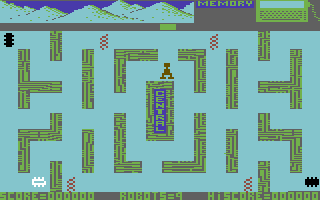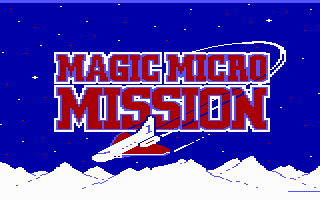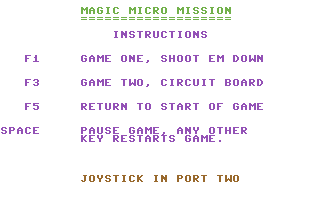Retro Replay Review
Gameplay
Magic Micro Mission presents a two-act structure that keeps the action fresh and engaging. The first stage drops you into a simplistic yet addictive cockpit-based shooter. Flying saucers zip past in smooth elliptical arcs, requiring quick reflexes and precise joystick control to line up your cross-hair and fire before they vanish off-screen. The challenge lies in balancing your aim with the saucers’ unpredictable entry and exit points—miss too many and the tension ramps up quickly.
Transitioning into the second stage, the gameplay shifts into a maze-clearer reminiscent of classic arcade hits. You control Zog, a small cleaning robot tasked with wiping up patches of oil scattered across a vibrant circuit-board grid. The pacing is more methodical here, encouraging route optimization to clean every spot efficiently. Adding to the excitement, three chip sprites dart freely around the maze, while resistors patrol vertical columns, forcing you to weave between hazards and time your movements carefully.
The duality of gameplay styles in Magic Micro Mission—fast-paced shooting followed by strategic maze navigation—creates a satisfying ebb and flow. Each act tests different skill sets: hand-eye coordination and target tracking in the shooter, then planning and risk assessment in the maze. Despite its vintage origins, the game’s structure feels balanced, offering bursts of adrenaline in the cockpit and thoughtful pacing on the circuit board.
Controls are simple yet responsive. The joystick handles both aiming and movement with minimal input lag, and a single fire button does the job. Though limited by the hardware of its time, the tactile feel remains surprisingly intuitive. Players seeking a straightforward challenge will find the simplicity refreshing rather than restrictive.
Graphics
Visually, Magic Micro Mission embraces the charm of early 1980s microcomputer titles. In the shooter stage, the cockpit view is rendered with bold, blocky lines to represent targeting reticles and saucer silhouettes against a stark black backdrop. While primitive by today’s standards, the crisp contrast helps you track enemy movement clearly, preventing any confusion about your next shot.
The maze stage bursts with color on the circuit-board grid. Each tile represents a segment of a printed circuit, rendered in bright greens and oranges to evoke an electronic underworld. The oil patches stand out in a darker hue, making your cleaning objectives immediately visible. Enemy chips flicker with simple animation frames as they change direction, while resistors slide smoothly up and down their columns—an elegant use of limited sprite capabilities.
Despite the minimal detail, the game’s aesthetic is cohesive. The two distinct visual styles serve their respective purposes well: high contrast for quick targeting in the shooter, vibrant and busy for strategic navigation in the maze. This design clarity prevents visual overload, ensuring you can focus on gameplay rather than deciphering the screen.
For collectors and retro enthusiasts, the graphics deliver an authentic hit of nostalgia. Every pixel and color choice speaks to the era of the Central ITV broadcast, transporting players back to mid-1980s living rooms. If you appreciate vintage presentation over modern polish, Magic Micro Mission will charm you with its earnest simplicity.
Story
Originating from the title sequence of the Central ITV series Magic Micro Mission, this game expands a brief television premise into interactive form. The overarching narrative is minimal: you’re a defender of Earth’s mainframe, battling rogue saucers in orbit before delving into the circuits where oil leaks threaten system stability. While there’s no extensive dialogue or cutscene exposition, the implied scenario is enough to frame your actions with purpose.
In the absence of a detailed plot, the game leans on thematic consistency. The saucer invasion and the failing circuit infrastructure combine to convey a classic sci-fi trope—advanced technology gone awry. This creates a loose but satisfying motivation for each stage, guiding you from space dogfights to intricate maze puzzles under one unified “technology under siege” banner.
Magic Micro Mission’s story is more backdrop than focal point, but that simplicity has its appeal. It lets players dive straight into the action without wading through lengthy exposition. In an era when many games offered thin narratives, this title strikes a solid balance by providing just enough context to keep you invested in each mission segment.
Overall Experience
Magic Micro Mission stands out as a compact yet varied entry in the pantheon of early ’80s microgames. Its two distinct gameplay stages offer bite-sized thrills and thoughtful challenges, making it ideal for short play sessions or longer runs aiming for a perfect clean and high saucer count. The blend of shooter and maze mechanics demonstrates creativity within the hardware’s constraints.
The game’s simplicity is its greatest strength. Controls are intuitive, objectives are clear, and the challenge curve rewards skill refinement rather than memorization of convoluted patterns. Whether you’re a retro gaming veteran reliving childhood memories or a newcomer curious about video game history, you’ll find Magic Micro Mission accessible and charming.
While it lacks modern bells and whistles—no voiceovers, no detailed storyline, and rudimentary audio beeps—it captures the spirit of its television origins with authenticity. The concise presentation, coupled with surprisingly tight gameplay loops, ensures it doesn’t overstay its welcome. Those seeking a nostalgia trip or a taste of early UK microcomputing will appreciate this title for its earnest approach and straightforward fun.
In sum, Magic Micro Mission delivers a balanced, engaging experience that belies its modest programming. Its clever dual-stage design, vibrant circuit-board mazes, and responsive shooter mechanics combine into a package that remains enjoyable decades after its original broadcast tie-in. For collectors, retro enthusiasts, or anyone looking to explore gaming’s formative years, this is a mission well worth undertaking.
 Retro Replay Retro Replay gaming reviews, news, emulation, geek stuff and more!
Retro Replay Retro Replay gaming reviews, news, emulation, geek stuff and more!









Reviews
There are no reviews yet.